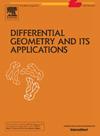A remark on deformation of Gromov non-squeezing
IF 0.7
4区 数学
Q3 MATHEMATICS
引用次数: 0
Abstract
Let be as in the classical Gromov non-squeezing theorem, and let . We first conjecture that the Gromov non-squeezing phenomenon persists for deformations of the symplectic form on the range (w.r.t. the standard metric) ϵ-nearby to the standard symplectic form. We prove this in some special cases, in particular when the dimension is four and when . Given such a perturbation, we can no longer compactify the range and hence the classical Gromov argument breaks down. Our main method consists of a certain trap idea for holomorphic curves, analogous to traps in dynamical systems.
关于Gromov非挤压变形的评述
设R, R和经典Gromov非压缩定理一样,设λ =(πR2 - πR2)/ πR2。我们首先推测,对于辛形式的变形,在C0 (w.r.t.标准度规)ϵ-nearby到标准辛形式的范围内,Gromov非压缩现象持续存在。我们在一些特殊情况下证明了这一点,特别是当维度是4和R<;2r时。给定这样的扰动,我们就不能再紧化值域,因此经典的Gromov论证就失效了。我们的主要方法包括全纯曲线的陷阱思想,类似于动力系统中的陷阱。
本文章由计算机程序翻译,如有差异,请以英文原文为准。
求助全文
约1分钟内获得全文
求助全文
来源期刊
CiteScore
1.00
自引率
20.00%
发文量
81
审稿时长
6-12 weeks
期刊介绍:
Differential Geometry and its Applications publishes original research papers and survey papers in differential geometry and in all interdisciplinary areas in mathematics which use differential geometric methods and investigate geometrical structures. The following main areas are covered: differential equations on manifolds, global analysis, Lie groups, local and global differential geometry, the calculus of variations on manifolds, topology of manifolds, and mathematical physics.

 求助内容:
求助内容: 应助结果提醒方式:
应助结果提醒方式:


